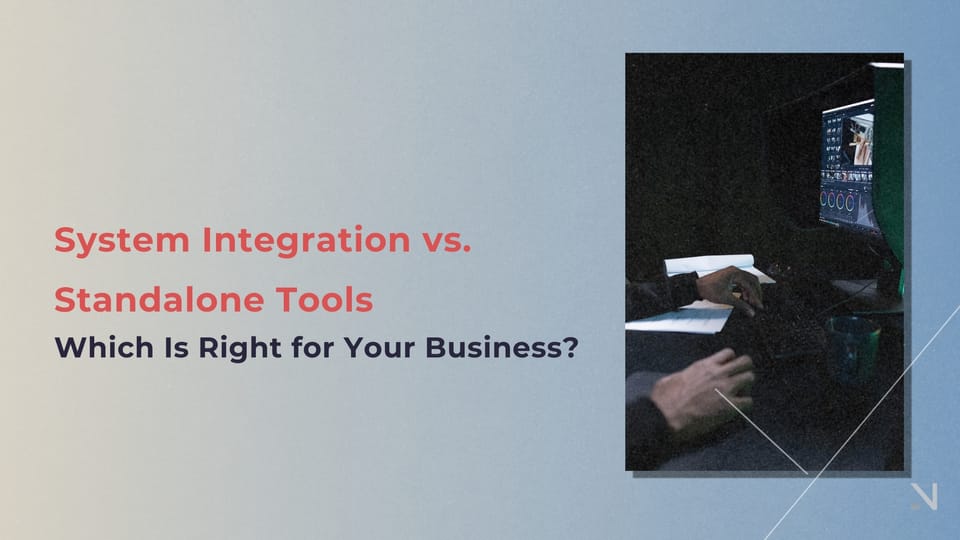System Integration vs. Standalone Tools: Which Is Right for Your Business?
Narima Digital •

If you’ve been searching for the best way to streamline your business operations, you’ve probably come across two common approaches: system integration and standalone tools. But which one is right for your business? At Narima, we’ve worked with companies of all sizes, and we understand that this decision isn’t always straightforward. So let’s break it down and help you make the best choice for your needs.
Standalone Tools: The Simple Solution
Standalone tools are exactly what they sound like—individual software or applications designed to perform a specific task. These tools are often easy to implement and highly focused. For example, a project management tool might help you track team progress, or an accounting app might handle invoices and expenses.
When Standalone Tools Work Best
- Small Businesses or Startups: If you’re just starting out, standalone tools can be a quick and cost-effective solution. They’re great for handling specific tasks without requiring a significant investment.
- Limited Scope: Standalone tools are ideal when your needs are straightforward and don’t require extensive collaboration between departments.
- Easy Learning Curve: These tools are often user-friendly, making it easier for your team to adopt and use them effectively.
The Downsides of Standalone Tools
While standalone tools can be a great starting point, they come with limitations:
- Lack of Integration: As your business grows, you might find yourself juggling multiple tools that don’t communicate with each other, leading to inefficiencies and data silos.
- Scalability Issues: Standalone tools often lack the flexibility to adapt to complex or expanding business needs.
- Repetitive Data Entry: Without integration, your team may spend valuable time manually transferring data between systems.
System Integration: The Holistic Approach
System integration brings all your tools and software together, creating a unified ecosystem. Imagine your CRM, accounting software, project management app, and e-commerce platform working seamlessly as one. That’s the power of system integration.
When System Integration Shines
- Growing or Complex Businesses: If your operations span multiple departments or involve intricate workflows, integration can streamline processes and eliminate redundancies.
- Improved Data Flow: With integrated systems, data flows effortlessly between applications, reducing errors and ensuring that everyone has access to up-to-date information.
- Enhanced Efficiency: Integration saves time and resources by automating repetitive tasks and centralizing your operations.
The Challenges of System Integration
While system integration offers incredible benefits, it’s not without its challenges:
- Initial Investment: Integration projects can require a significant upfront cost in terms of time, money, and resources.
- Complex Implementation: Integrating systems often requires technical expertise, making it essential to work with experienced professionals.
- Ongoing Maintenance: As your business evolves, you’ll need to ensure your integrated systems continue to work harmoniously.
Choosing the Right Approach for Your Business
Here are a few key questions to consider when deciding between standalone tools and system integration:
- What Are Your Business Goals?
- If you need a quick solution for a specific task, standalone tools might be enough.
- If you’re aiming for long-term growth and efficiency, integration could be the better investment.
- How Complex Are Your Operations?
- For simple workflows, standalone tools can do the job.
- For businesses with interconnected departments and data needs, integration is essential.
- What’s Your Budget?
- Standalone tools are generally more affordable upfront.
- While integration may require a higher initial investment, it often delivers greater ROI in the long run.
- What’s Your Team’s Technical Expertise?
- If your team isn’t tech-savvy, standalone tools might be easier to adopt.
- For integration, partnering with experts (like us!) can simplify the process and ensure success.
How Narima Can Help
At Narima, we specialize in tailoring solutions to your unique business needs. Whether you’re considering standalone tools or exploring system integration, we’ll guide you through the process to ensure you get the best results. Here’s how we can help:
- Consultation: We’ll assess your current tools and workflows to recommend the best approach.
- Implementation: From setting up standalone tools to managing full-scale integrations, our team handles it all.
- Support: We’ll be there post-launch to ensure your systems run smoothly and adapt as your business evolves.
There’s no one-size-fits-all answer to whether standalone tools or system integration is right for your business. It all depends on your goals, needs, and resources. The good news? You don’t have to figure it out alone. At Narima, we’re here to help you navigate the options and choose the solution that sets your business up for success.
Ready to make the choice that’s right for you? Let’s talk and build something amazing together.


